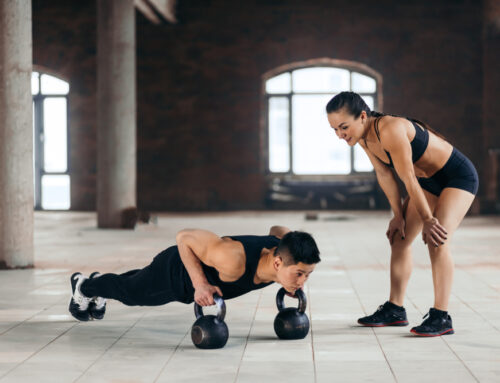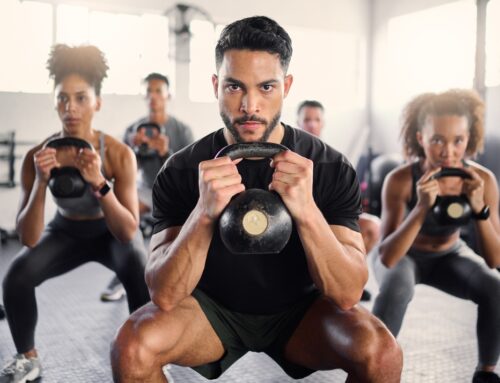If you’re new to the world of yoga you may not be familiar with the lingo, movements, or poses, but there are some basic yoga poses that are known to be beginner friendly. There are a wide range of yoga poses that are geared towards more yogi experts and the yogi newbies. When you get a strong grasp of basic, foundational yoga poses that can help you to move into more challenging poses for further growth and balance.
Let’s look at some yoga basics with an easy guide for beginners to practice in the gym or at home!
What is Yoga?
Before we look at some beginner friendly poses, we need to get a good understanding of what yoga actually is. Yoga is more than just stretches and fluid motions, it is a powerful form of aerobic exercise with its influence rooted in gymnastics and wrestling. More directly, Merriam-Webster defines yoga as, “a system of physical postures, breathing techniques, and sometimes meditation derived from Yoga but often practiced independently especially in Western cultures to promote physical and emotional well-being.”
When you begin yoga you may notice emphasis on stretch, focus, breath, balance, and strength which are all essential aspects of each yoga. In the world of yoga you can’t have one of these elements without the other, they are all central to each flow and movement.
We have previously highlighted the benefits of yoga beyond physical exercise, and the different types of yoga we offer at Carbon Performance. Be sure to check it out to gain even more insight into this world while also reading up on poses that can help with heart health, sleep, and anxiety.
Some Common Yoga Phrases for Beginners
When you enter into your first couple yoga classes you may pick up on a few words that are unfamiliar to you, but common in the world of yoga. Here are some common yoga phrases and what they mean so that you can feel more prepared when you first enter a yoga session:
“Namaste” = I bow to you, which is usually said towards the end of a session, with palms together near the chest.
“Lengthen the spine” = Extend spine to make space in back, or sitting more upright with shoulders back, commonly said during specific movements
“Breathe” = A reminder to focus on breathing during stretching and movements, this helps to deep your stretch
“Chaturanga” = A plank like pose to help transition between yoga poses and movements with fluidity.
Yoga and The Importance of Breathwork
One major component of yoga is the importance and focus on breathwork. It is common for yoga instructors to remind you to “inhale, exhale” or “breathe” throughout poses and movements. For one, focusing on your breath during yoga can help to “clear your mind” and become more present with the movements, and can help to bring a sense of calm to the mind and body. Think of it as another layer of mediation within your yoga session. Secondly, breathing during certain poses and movements can actually allow you to deepen the stretch or move.

Yoga Equipment Essentials
Now that you have some insight into the background of yoga, and what to expect within a session, there are some practical yoga equipment that you may want to pick up before your first session. While many gyms offer yoga equipment for their classes, sometimes it can be helpful to have your own equipment in case you want to practice some movements outside of the gym!
Here are some essential yoga equipment:
- Yoga Block: A block shaped made out of foam or rubber to help support the body during specific yoga poses.
- Yoga Strap: These straps help you to reach and stretch for a better range of motion.
- Yoga Mat: It’s what you sit and stand on during every yoga session! They’re usually made of rubber or PVC and easy to clean after each class.
- Water Bottle: No matter if a workout is low or high impact, a water bottle is always an essential.
- Yoga clothes: Since a yoga class is filled with lots of movements that will require bends, flexibility, and stretching you will want to go for breathable, stretchy clothes like yoga leggings or yoga pants with the appropriate top.
- Essential oils: To create a better sense of calm and relaxation, some people will place essential oils on their wrist or pulse points. However, be mindful of which scent you select and how much you use, as you do not want the scent to bother your yoga neighbor.
Top 5 Yoga Poses for Beginners
If you’re looking for some basic poses for beginners, here are 5 common yoga poses to see a class..
1. Standing Poses
A standing yoga pose is what it sounds like where you are often standing, or most of the weight is on your legs or feet. Standing poses are an excellent way to usher in focus and meditation at the beginning of a yoga class. Here is one common standing yoga poses:
Tree Pose
Stand with your feet together on the mat, shift weight to either left or right side with the opposite leg bending out, then placing it either on the ankle, calf, or upper thigh of the planted leg. Raise hands above head, palms together, and breathe.
2. Balancing Poses
Balance is a main key player in moves and poses for yoga, and is helpful for coordination and even better posture. These kinds of poses can be daunting for those who may not have the most confidence in their balancing skills, but with more practice and dedication you’d be surprised at how quickly you can grow in this area! One common balancing poses in yoga:
Chair Pose
Stand with both feet planted firmly below you on the mat, with all ten toes connected to the ground, bend at knees while pushing hips back, as if you’re sitting in an invisible chair, knees shouldn’t go past your toes, arms go up by your ears with palms facing each other.
3. Seated Poses
Seated poses focus on stretching the lower parts of the body such as the hamstrings and hips, where tension can often be found. A common seated pose seen in a yoga class is:
Seated Forward Bend
Start by sitting on your mat with your legs extended in front of you, extend your arms above, next to your ears, and hinge forward with your arms guiding you towards your feet, while lengthening the spin. There may be some discomfort, which is normal, as it is a big stretch, but just remember to breathe.
4. Backbend Poses
With a backbend pose, you will mainly be doing a pose or movement that will bend the back or rather the spin for a further stretch. This can help with back pain and balance over time. Similar to a seated pose, a backbend pose can cause slight discomfort due to the tension many of us hold in our back, but this is completely normal. One popular backend pose for beginners is:
Sphinx Pose
On your mat, lie on your stomach face down, then press the top of your feet, and hips into the mat while lifting your chest and upper body by using your arms or forearms, be sure to breathe.
5. Resting Poses
Typically resting poses are one of the final poses at the end of a yoga class as they provide a moment to rest before the session is up. You can view it as one final moment to relax, and unwind, before going back into the world! One resting pose that is often used at the end of a yoga session is:
Child’s Pose
Begin by sitting on the back of your heels, length the spine, and reach forward to the mat while gently allowing your forehead to connect with the floor, you can continue to reach forward with your fingertips if possible, and be sure to breathe.
The beauty about all of these poses is that they are easy to follow as a beginner in yoga, and can be practiced in and outside of a yoga session.
FAQ Yoga Questions for Beginners
Why is Yoga Hard at First?
When you’re first starting out with yoga you may find it hard or challenging. This is normal and is most likely due to tightness in muscles leading to flexibility problems. You will want to listen to your body, and not overextend yourself in these moments. But, the more you practice different yoga poses and movements you will find that your muscles and body are more flexible and able to move and bend easily.
Yoga can also be challenging at first considering that mind-muscle connection, which is at the core of yoga, is foreign to some people at first. With practice this should all become easier, even if it’s challenging or feels awkward at first. Don’t rush the process, rather give it time!
How Many Times a Week Should a Beginner Do Yoga?
The answer to this question can be complex as many people have different schedules and availability to attend a yoga class or session. Ideally, you’ll want to practice yoga at least 1-3 times a week either in a class setting or at home. This can keep the consistency you will need to work on stretching muscles with the proper flexibility and movements.
But above all, something is better than nothing. So, if you don’t quite have a structured yoga routine, then do it when you can, with the goal of at least one weekly session. The easiest way to do this is to sign up for a weekly yoga class, like at Carbon Performance!
Is Yoga Better in the Morning or Night?
If you’re unsure if you should practice yoga in the morning or at night, you’ll first need to know what your goals are. If you’re needing a low-impact workout in the morning before work or a busy day, yoga can be the thing to get your body moving and provide energy to start the day. But, if you’re looking for something to help you unwind in the evening after dinner and before bed, then yoga at night can help to usher in more relaxation and calmness.
Yoga with Carbon Performance
At Carbon Performance, we proudly offer two forms of yoga class. Yoga sculpt to focus more on enhancing muscle tone and flexibility, and Recovery yoga to bring in recovery between or after workouts. Both are excellent ways to get more familiar with the world of yoga with skilled yoga instructors to guide you through each movement and session.
Beyond yoga, we also offer additional group workouts such as:
- Cycling
- Mat Pilates
- Les Mills Body Pump
Be sure to check us out online, but also in person by visiting any of our locations. We would be happy to give you a tour of our facilities, review membership options, and answer any questions you may have regarding your fitness goals and journey.
At Carbon Performance our goal is to elevate your fitness journey through encouragement, confidence, and accountability. We look forward to meeting you on your journey!







